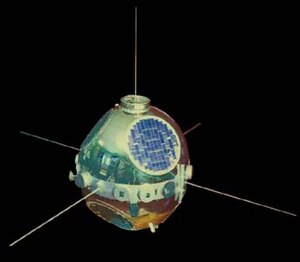Explorer 30
It has been suggested that this article be merged into SOLRAD 8. (Discuss) Proposed since January 2022. |
 Explorer 30 satellite | |
| Names | Solrad 8 Solrad VIII Solar Explorer-A [1] |
|---|---|
| Mission type | Solar physics |
| Operator | NASA / NRL |
| COSPAR ID | 1965-093A |
| SATCAT no. | 01738 |
| Mission duration | 21 months (planned) |
| Spacecraft properties | |
| Spacecraft | Explorer XXX |
| Spacecraft type | Solar Explorer |
| Bus | SOLRAD |
| Manufacturer | Naval Research Laboratory |
| Launch mass | 56.7 kg (125 lb) |
| Start of mission | |
| Launch date | 19 November 1965, 04:48:27 GMT[2] |
| Rocket | Scout X-4 (S-138R) |
| Launch site | Wallops Flight Facility, LA-3 |
| Contractor | Vought |
| Entered service | 19 November 1965 |
| End of mission | |
| Last contact | August 1967 |
| Orbital parameters | |
| Reference system | Geocentric orbit[3] |
| Regime | Circular orbit |
| Perigee altitude | 704 km (437 mi) |
| Apogee altitude | 891 km (554 mi) |
| Inclination | 59.70° |
| Period | 100.80 minutes |
| Instruments | |
| Solar X-Ray and Ultraviolet Monitor | |
Explorer program | |
Explorer 30, also SOLRAD 8 or SE-A, was a NASA satellite was one of the SOLRAD (Solar Radiation) program that began in 1960 to provide continuous coverage of solar radiation with a set of standard photometers. Explorer 30 was a spin-stabilized satellite oriented with its spin axis perpendicular to the Sun-satellite line so that the 14 solar X-ray, and ultraviolet photometers pointing radially outward from its equatorial belt viewed the Sun on each revolution. Data were transmitted in real time by means of an FM / AM the satellite's telemetry system and were recorded by the stations on the Spacecraft Tracking and Data Acquisition Network (STADAN) tracking network.[1]
Eclipse 1966[]
The satellite observed the solar eclipse on 20 May 1966.[4] This observation may have been the first observation of a solar eclipse by an artificial satellite.[4]
Mission[]
The satellite performed normally, except for the spin system, which failed to maintain 60 rpm (at spin rates below 10 rpm data reduction became difficult). The spin rate gradually decreased to 4 rpm on 12 September 1966. At that time, ground command succeeded in reactivating spinup to 78 rpm, which exhausted the gas supply. From this point, the spin rate gradually decreased to 10 rpm in August 1967, when data collection was substantially decreased.[1]
Experiment[]
Solar X-Ray and Ultraviolet Monitor[]
This experiment was designed to monitor solar X-ray and ultraviolet emissions with a set of standardized detectors so that the data could be compared directly with that produced by other experiments in the SOLRAD series. Eight ion chambers and two Geiger counters covering the spectral regions from 0.5 A to 60 A and 1080 A to 1350 A were mounted perpendicular to the satellite spin axis. Analog outputs from the detectors were transmitted continuously on six IRIG telemetry channels. The experiment provided good data for all detectors from 27 November 1965 to 24 August 1967, with the following exceptions: (1) the Lyman-alpha detector and the UV detectors were saturated for normal aspect angles, (2) the core memory failed at launch so that the data were collected in real-time telemetry only, and (3) a gradual decrease in spin rate caused the aspect angle to drift away from normal in the second year of operation.[5]
See also[]
- Explorer program
References[]
- ^ a b c "Display: Explorer 30 (Solrad 8) 1965-093A". NASA. 28 October 2021. Retrieved 9 November 2021.
 This article incorporates text from this source, which is in the public domain.
This article incorporates text from this source, which is in the public domain.
- ^ "Launch Log". Jonathan's Space Report. 21 July 2021. Retrieved 9 November 2021.
- ^ "Trajectory: Explorer 30 (Solrad 8) 1965-093A". NASA. 28 October 2021. Retrieved 9 November 2021.
 This article incorporates text from this source, which is in the public domain.
This article incorporates text from this source, which is in the public domain.
- ^ a b Landini, M.; Russo, D.; Tagliaferri, G. L. (1966). "Solar Eclipse of 20 May 1966, observed by the Solrad 8 Satellite in X-ray and Ultraviolet Bands". Nature. 211 (5047): 393. Bibcode:1966Natur.211..393L. doi:10.1038/211393a0. S2CID 4174785.
- ^ "Experiment: Solar X-Ray and Ultraviolet Monitor". NASA. 28 October 2021. Retrieved 9 November 2021.
 This article incorporates text from this source, which is in the public domain.
This article incorporates text from this source, which is in the public domain.
- Explorers Program
- Spacecraft launched in 1965
- Satellites formerly orbiting Earth